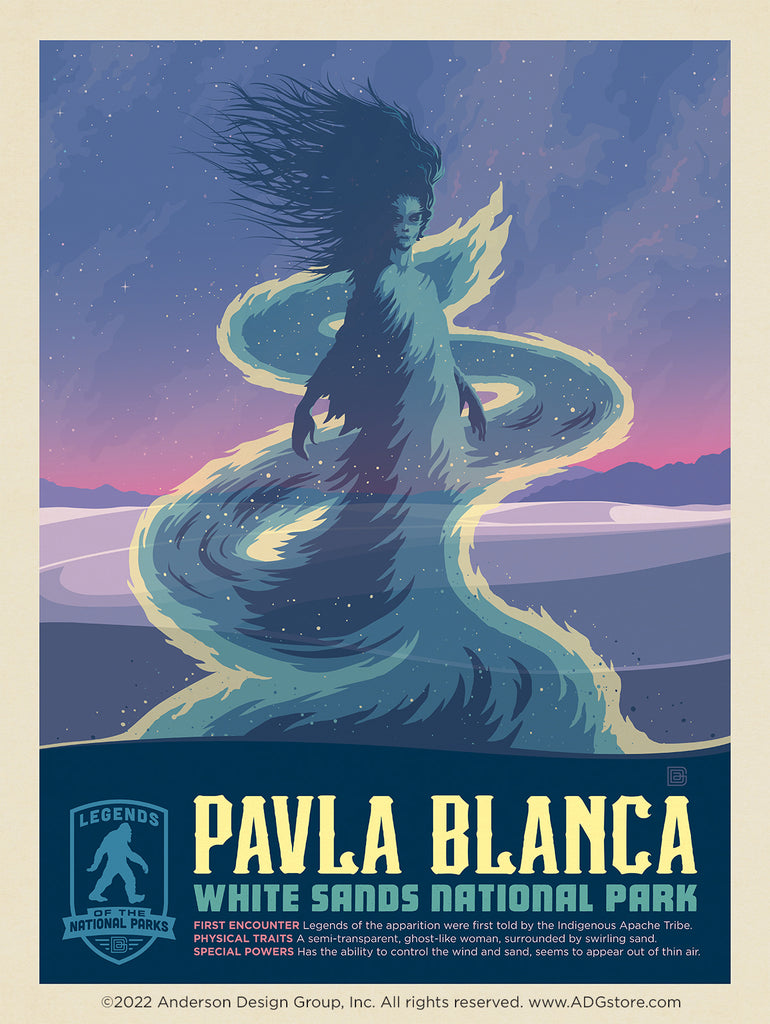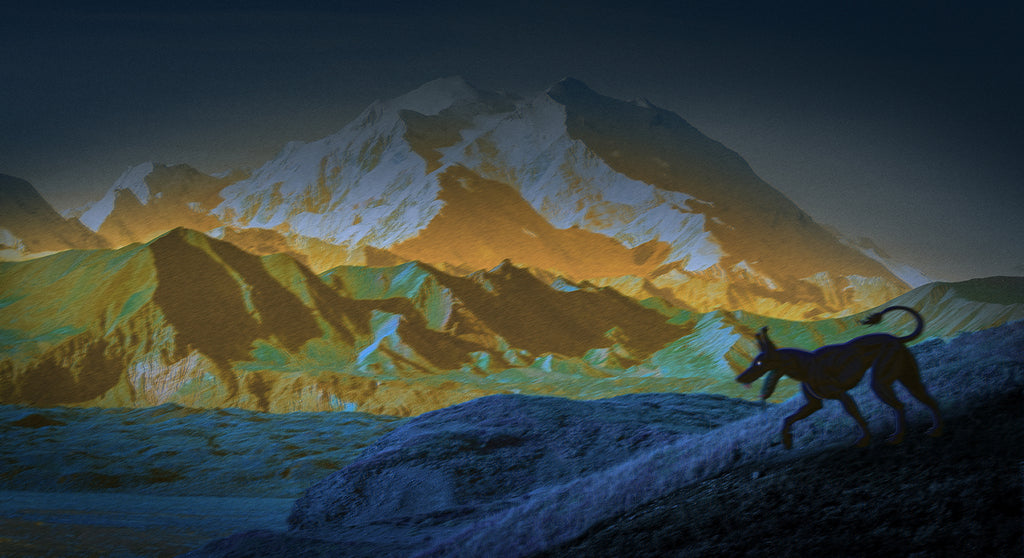Traveling to a National Park? Be on the Lookout for These Six Spooky Legends!
If you love spooky stories, exciting campfire talks, Indigenous legends, and folklore tall tales, this is the blog for you!
Anderson Design Group artists launched a new collection, Legends of the National Parks. This poster art collection features all the scary creatures and mythical beasts said to haunt the 63 American National Parks. Read on to learn about the legends, or visit the collection to see what our artists have created!
Great Smoky Mountains National Park; Home of Spearfinger
Those who would walk in the woods of Great Smoky Mountains National Park should take care, for Spearfinger may be nearby! Spearfinger is an ancient Cherokee legend who, according to the tribal elders who tell her tale, is a monster who takes on the form of an old woman. Some say she is a witch, while others insist she is an ancient spirit as old as the world itself.

Despite differing accounts among Cherokee tribes of how Spearfinger came to be, all Indigenous elders agree she is evil. As the legend goes, Spearfinger has stone-like skin and only somewhat resembles a human. She is cruel and deceptive, and she likes to shape-shift into a seemingly harmless old woman, all the better to trick her victims. According to the Cherokee tales, Spearfinger hunts for livers, using the sharpened tip on her right finger to attack children and pluck their livers from them.
Thankfully, Cherokee stories also say that Spearfinger was finally brought to an end. Though her skin was made of stone and the Cherokee arrows were useless against it, a wise Chickadee bird flew to the Cherokee warriors and told them of Spearfinger’s weakness, her right hand. Cherokee warriors captured Spearfinger, attacked her right hand, and defeated her.
Or was she truly defeated? Her body was never recovered from the battle, so it may be true that Spearfinger lives on in Great Smoky Mountains National Park, waiting for the right moment to resume her hunt.
Denali National Park; Beware the Prowling Keelut Beast
Alaska is the Last Frontier, the last place in America with huge swaths of land that remain unexplored. A land as wild and mysterious as this gives meaning to the ghost stories and Indigenous Inuit legends that surround such a land. Some of those ghost stories are particularly frightening, like the story of the Keelut creature.

According to Inuit stories told by tribes ranging all the way from the Alaskan tundra to the Baffin Island in Canada, the Keelut is a huge black canine animal, hairless and fierce. The Keelut is said to be a spirit of death because it is said to hunt people at night. As the legend has it, the beast is particularly fond of wayward travelers who have gotten lost or who have been foolish enough to wander the Alaskan wilderness alone after the sun has gone down. The Keelut is also said to have spiritual, mystic powers, a creature that lives both in the spirit world and the natural world. It comes from the underworld, but it can take physical form when it hunts its prey. It is also said to be more active during winter, though Inuit legends contain stories of the creature hunting its prey during other seasons of the year.
Though the Keelut beast is truly fearsome in appearance, tribal elders who speak of the creature do not tell of it physically attacking its prey. The Inuit legends say the creature stalks its prey, yes, but all it has to do is make eye contact, and it can cause even the strongest-willed person to forget who they are, to become paralyzed. The disoriented victim falls to the ground and soon dies of hypothermia, allowing the Keelut to move in for the feast.
Shenandoah National Park; Spot the Snallygaster Bird Before it Gets You!
Shenandoah National Park is said to be the Gem of the Old Dominion State, one of the most frequently visited nature preserves in Virginia. But the park has a mystery too, the possibility of a fearsome Snallygaster monster living in the park!

The Snallygaster is a huge winged beast, part-reptile, part-bird, quite ferocious and scary. The bird-beast is said to have serrated teeth, hooked talons, and a tail more than 20 feet long. The creature looks similar to a dragon, but it does not breathe fire. However, the Snallygaster can put forth a piercing cry, louder than a locomotive and capable of stunning nearby prey.
A newspaper clip from 1909 reported the direct words of a local resident in Frederick County, Maryland, someone who saw the Snallygaster and lived to tell the tale! This resident said that the beast had, “Enormous wings, a long pointed bill, claws like steel hooks, and an eye in the center of its forehead.” Other reports suggest the creature had octopus-like tentacles coming out of its mouth, perhaps to suck the blood of its victims.
White Sands National Park; Sandstorms Caused by Pavla Blanca
This is the story of Pavla Blanca. In the early-1540s, the Spanish conquistador Hernando de Luna set off from Mexico City to explore the region that is now Arizona, New Mexico, Kansas, and Texas. During their journey, Hernando de Luna’s group was attacked by warrior Apaches. After sustaining heavy losses and injuries, the conquistadors retreated and began their journey back to Mexico City. On their way back, the group passed through what is now White Sands National Park, in New Mexico. It is said that Hernando de Luna died from his injuries there, but his body was never found.

Mañuela, Hernando de Luna’s bride-to-be, set off for the sand dunes, refusing to believe the surviving conquistadors who told her of her loved one’s misfortune. Manuela entered the White Sands region in the mid-1540s, never to be seen again. Indigenous legends from Apache tribes tell that her ghost has haunted the sand dunes ever since, though she is not fierce or aggressive.
Rather, Mañuela (referred to as Pavla Blanca), roams across the sand dunes every night, looking for her lost fiancé. The swirling sand eddies and the whispers of sand flowing across the dunes are believed by many to be caused by the ghost maiden, still searching for her lost lover to this day.
Everglades National Park; Keep an Eye Out for the Elusive Swamp Ape
Though it is well known that Everglades National Park is full of creatures large and small, both fierce and harmless, some believe that the park is also home to a mysterious creature that might be related to Bigfoot! This is Swamp Ape, a 5ft-7ft tall ape-like creature that is said to be covered in mottled reddish-brown hair. Eyewitnesses have said the creature has ape-like features, long arms and legs, a hunched back, and a gorilla-like face. The creature is also said to ward off prying eyes and predators with a horrid stench that it can emit, giving the creature the nickname “Skunk Ape.”

The Bigfoot Field Researchers Organization has recorded over 333 sightings of Swamp Ape in Florida, plus 137 sightings in Georgia and 100 in Alabama. While most sightings have been recorded between the 1960s and the present, stories of Swamp Ape go back to an 1818 newspaper story of a man-sized ape raiding food stores and stalking Everglades fisherman. Indigenous stories of ape-like creatures living in South Florida go back even further.
Reports of Swamp Ape skyrocketed in the mid-20th century. Entire tour buses full of people in the Everglades said they witnessed the creature, and even Miami-Dade law enforcement officials said they saw the beast. Unsurprisingly, Swamp Ape is now a cultural icon of South Florida, and there is even a museum dedicated to the creature.
Acadia National Park; Beware the White Walker!
An ancient Indigenous Penobscot, Micmac, and Passamaquoddy legend harkening back to a time when wigwams and teepees dotted the Maine landscape rather than buildings and roads, the White Walker is said to be a tall, lumbering, feral beast, similar in size and appearance to the Bigfoot of the Pacific Northwest. However, the White Walker is said to be covered in white fur, not brown or black fur as in the case of Bigfoot.

Indigenous Americans had many names for what we now call White Walkers. One, “Kiwakwa,” translates to “walks about the woods.” Other Indigenous names for the creature include “Chenoo” and “Apotamkin.” As the legend goes, this creature was once a man but became possessed by dark magic and turned into a horrible beast when he committed awful crimes against his tribesmen.
The Indigenous legends say that, once turned into a White Walker, the creature wanders northern forests at night, hunting humans, shrieking its shrill, piercing cry, and preying on lonely travelers who journey through the woods alone. While some stories say the White Walker’s heart is made of ice and can be cured with certain Native American herbal medicines (healing the White Walker and returning him to a human state), there are few accounts of this being done successfully.
Never a Dull Moment in America's 63 National Parks!
Raise your hand if you'll be looking over your shoulder more often than usual on your next visit to a National Park! We know we will be! Stay tuned for the next installment in our series on the Legends of the National Parks, and let us know which poster design is your favorite!
Until next time,
- Ren Brabenec
Anderson Design Group Staff Writer
← Older Post Newer Post →

